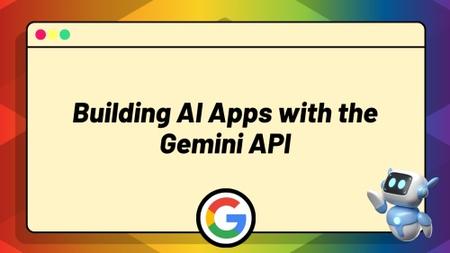English | MP4 | AVC 1920×1080 | AAC 44KHz 2ch | 39 Lessons (3h 43m) | 584 MB
Learn to use Google’s Gemini API for building AI-powered applications. Plus you’ll put your skills into action by building three projects using the Gemini API.
Take your first step into the world of AI application development by diving deep into a fundamental technology: Google’s Gemini API. You’ll learn everything there is about utilizing the API to power your AI applications with Google’s leading Large Language Models.
WHAT YOU’LL LEARN
- Learn to make API calls with Google’s Gemini Pro and Pro Vision AI models for dynamic applications.
- Understand the nuances of Gemini’s multimodal models: Nano, Pro, and Ultra, for versatile AI development.
- Master Google AI Studio for crafting freeform prompts with variables and parameters, enhancing your AI interactions.
- Gain insights into Gemini API’s generation parameters for fine-tuned control over AI response generation.
- Dive into practical AI with three projects: develop a conversational AI agent, create an interactive “Talk to an Image” app, and build an AI-powered Image Organizer.
- Harness prompt engineering techniques and integrate AI into classic applications for next-level development skills.
Table of Contents
1 Introduction
2 What We’re Using
3 Jupyter Notebook
4 Google Colab
5 Getting a Gemini API Key
6 Installing the Python SDK for Gemini API and Authenticating to Gemini
7 Gemini Multimodal Models Nano, Pro, and Ultra
8 Google AI Studio Freeform Prompts With Gemini Pro Vision
9 Google AI Studio Using Variables and Parameters in the Prompt
10 Generating Text From Text Inputs Gemini Pro
11 Streaming Model Responses
12 Generating Text From Image and Text Inputs Gemini Pro Vision
13 Gemini API Generation Parameters Controlling How the Model Generates Responses
14 Gemini API Generation Parameters Explained
15 Building Chat Conversations
16 Project Building a Conversational Agent Using Gemini Pro
17 Introduction to Gemini 1.5 Pro
18 System Instructions
19 The File API Prompting with Media Files
20 Tokens
21 Prompting with Audio
22 Project Requirements
23 Building the Application
24 Testing the Application
25 Streamlit Transform Your Jupyter Notebooks into Interactive Web Apps
26 Creating the Web App Layout With Streamlit
27 Saving and Displaying the History Using the Streamlit Session State
28 Project Introduction
29 Getting Images Using a Generator
30 Renaming Images Using Gemini Pro Vision
31 Intro to Prompt Engineering the Gemini API
32 Tactic 1 – Position Instructions Clearly With Delimiters
33 Tactic 2 – Provide Detailed Instructions for the Context, Outcome, or Length
34 Tactic 3 – Specify the Response Format
35 Tactic 4 – Few-Shot Prompting
36 Tactic 5 – Specify the Steps Required to Complete a Task
37 Tactic 6 – Give Models Time to _Think_
38 Other Tactics for Better Prompting and Avoiding Hallucinations
39 Prompt Engineering Summary
Resolve the captcha to access the links!
